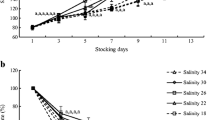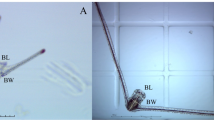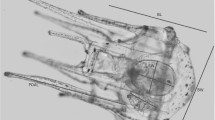Abstract
In order to optimize Pecten maximus larval performance and post-larval yield, larvae were fed five algal concentrations in the range 3–20 cells μL−1 in 2,800-L flow-through tanks without prophylactic antibiotics. Competent larvae were transferred to a commercial hatchery for settlement and provided uniform conditions for 4 weeks to observe effects. Increased diet concentration increased the sum of fatty acids (FA) in the total larval population, reaching 7 and 25 ng FA larvae−1 at 3 and 16 cells μL−1, respectively. The FA level in competent larvae was not affected by diet concentration and ranged from 30 to 46 ng larvae−1. Increased diet concentration increased larval growth rate, and the larvae were ready to settle 5 days earlier when fed 16 cells μL−1 compared to 3 cells μL−1. Larval ingestion rate increased during life span and with increased larval diet concentrations, but a considerable amount (40–60 %) of the added algal cells was lost from the larval rearing tanks due to the seawater flow. There was no effect on larval survival, final post-larval shell height, % of competent larvae transferred to settlement, or total yield of post-larvae. Final mean post-larval shell height was 509 μm and 25.5 % of competent larvae settled, resulting in a final post-larval yield between 6.9 and 17.6 % of the initial number of d3 larvae. Competent larvae with similar FA content produced similar numbers of post-larvae independent of diet concentration, even if higher diet concentrations resulted in higher rates of larval development and metamorphosis.







Similar content being viewed by others
Abbreviations
- FA:
-
Fatty acids
- tiso:
-
Tahitian Isochrysis galbana
- pav:
-
Pavlova lutheri
- chm:
-
Chaetoceros mulleri
- 3d:
-
Three day old
References
Andersen S, Naas KE (1993) Shell growth and survival of scallop (Pecten maximus L.) in a fertilized, shallow seawater pond. Aquaculture 110:71–86
Andersen S, Burnell G, Bergh Ø (2000) Flow-through systems for culturing great scallop larvae. Aquacult Int 8:249–257
Andersen S, Christophersen G, Magnesen T (2011) Spat production of the great scallop (Pecten maximus): a roller coaster. Can J Zool 89:585–604
Bergh Ø, Strand Ø (2001) Great scallop, Pecten maximus, research and culture strategies in Norway: a review. Aquacult Int 9:305–318
Christophersen G, Torkildsen L, van der Meeren T (2006) Effect of increased water recirculation rate on algal supply and post-larval performance of scallop (Pecten maximus) reared in a partial open and continuous feeding system. Aquacult Eng 35:271–282
Cragg SM (2006) Development, physiology, behaviour and ecology of scallop larvae. In: Shumway SE, Parsons GJ (eds) Scallops: biology, ecology and aquaculture. Elsevier, Amsterdam, pp 45–122
Delaunay F, Marty Y, Moal J, Samain J-F (1992) Growth and lipid class composition of Pecten maximus (L.) larvae grown under hatchery conditions. J Exp Mar Biol Ecol 163:209–219
Delaunay F, Marty Y, Moal J, Samain J-F (1993) The effect of monospecific algal diets on growth and fatty acid composition of Pecten maximus (L.) larvae. J Exp Mar Biol Ecol 173:163–179
Farías A, Uriarte I (2006) Nutrition in pectinids. In: Shumway SE, Parsons GJ (eds) Scallops: biology, ecology and aquaculture. Elsevier, Amsterdam, pp 521–542
Gallager SM, Mann R (1986) Growth and survival of larvae of Mercenaria mercenaria (L.) and Crassostrea virginica (Gmelin) relative to broodstock conditioning and lipid content of eggs. Aquaculture 56:105–121
Gallager SM, Roger M, Glenn CS (1986) Lipid as an index of growth and viability in three species of bivalve larvae. Aquaculture 56:81–103
Gerard A, Salaun M, Tritar S (1989) Criteria of larval competence to metamorphosis in Pecten maximus. Haliotis 19:373–380
Gouda R, Kenchington E, Hatcher B et al (2006) Effects of locally-isolated micro-phytoplankton diets on growth and survival of sea scallop (Placopecten magellanicus) larvae. Aquaculture 259:169–180
Gruffydd LD, Beaumont A (1972) A method for rearing Pecten maximus larvae in the laboratory. Mar Biol 15:350–355
Heasman MP, O’Connor WA, Frazer AWJ (1995) Evaluation of Hatchery production of scallops P. fumatus. Final Report to Fisheries Research and Development Corporation, Deakin, ACT, Australia, 191 pp
Helm MM, Bourne N, Lovatelli A (2004) Hatchery culture of bivalves. A practical manual. FAO fisheries technical paper. No 471. Food and Agriculture Organization of the United Nations, Rome 177 pp
Hofman EE, Powell EN, Bochenek EA et al (2004) A modelling study of the influence of environment and food supply on survival of Crassostrea gigas larvae. ICES J Mar Sci 61:596–616
Ibarra AM, Ramirez JL, Garcia GA (1997) Stocking density effects on larval growth and survival of two catarina scallop, Argopecten ventricosus (= circularis) (Sowerby II, 1842), populations. Aquac Res 28:443–451
Jorquera MA, Silva FR, Riquelme CE (2001) Bacteria in culture of the scallops Argopecten purpuratus (Lamarck, 1819). Aquacult Int 9:285–303
Le Pennec M, Paugam A, Le Pennec G (2003) The pelagic life of the pectinid Pecten maximus—a review. ICES J Mar Sci 60:211–223
Lu YT, Blake NJ (1996) Optimum concentration of Isochrysis galbana for growth of larval and juvenile bay scallops, Argopecten irradians concentricus (Say). J Shellfish Res 15:635–643
Lu YT, Blake NJ (1997) Clearance and ingestion rates of Isochrysis galbana by larval and juvenile bay scallops, Argopecten irradians concentricus (Say). J Shellfish Res 16:47–54
Lu YT, Blake NJ, Torres JJ (1999) Biochemical utilization during embryogenesis and metamorphosis in the bay scallop, Argopecten irradians concentricus (Say). J Shellfish Res 18:425–429
MacDonald BA (1988) Physiological energetics of Japanese scallop Patinopecten yessoensis larvae. J Exp Mar Biol Ecol 120:155–170
Magnesen T, Bergh Ø, Christophersen G (2006) Yields of great scallop, Pecten maximus, larvae in a commercial flow-through rearing system in Norway. Aquacult Int 14:377–394
Martínez G, Caceres LA, Uribe E et al (1995) Effects of different feeding regimens on larval growth and the energy budget of juvenile Chilean scallops, Argopecten purpuratus Lamarck. Aquaculture 132:313–323
Marty Y, Delaunay F, Moal J, Samain J-F (1992) Changes in the fatty acid composition of Pecten maximus (L.) during larval development. J Exp Mar Biol Ecol 163:221–234
Meier S, Mjøs SA, Joensen H et al (2006) Validation of a one-step extraction/methylation method for determination of fatty acids and cholesterol in marine tissues. J Chromatogr A 1104:291–298
Narvarte MA, Pascual MS (2001) Diet trials on tehuelche scallop Aequipecten tehuelchus (d’Orb) larvae. Aquacult Int 9:127–131
Nevejan N, Saez I, Gajardo G et al (2003a) Supplementation of EPA and DHA emulsions to a Dunaliella tertiolecta diet: effect on growth and lipid composition of scallop larvae, Argopecten purpuratus (Lamarck, 1819). Aquaculture 217:613–632
Nevejan N, Saez I, Gajardo G et al (2003b) Energy vs. essential fatty acids: what do scallop larvae (Argopecten purpuratus) need most? Comp Biochem Physiol Part B Biochem Mol Biol 134:599–613
Nicolas L, Robert R (2001) The effect of food supply on metamorphosis and post-larval development in hatchery-reared Pecten maximus. Aquaculture 192:347–359
Nicolas J, Corre S, Gauthie G et al (1996) Bacterial problems associated with scallop Pecten maximus larval culture. Dis Aquat Organ 27:67–76
O’Connor WA, Heasman MP (1997) Diet and feeding regimens for larval doughboy scallops, Mimachlamys asperrima. Aquaculture 158:289–303
Pernet F, Tremblay R, Bourget E (2003) Biochemical indicator of sea scallop (Placopecten magellanicus) quality based on lipid class composition. Part II: larval growth, competency and settlement. J Shellfish Res 22:377–388
Raby D, Mingelbier M, Dodson JJ et al (1997) Food-particle size and selection by bivalve larvae in a temperate embayment. Mar Biol 127:665–672
Robert R, Gérard A (1999) Bivalve hatchery technology: the current situation for the Pacific oyster Crassostrea gigas and the scallop Pecten maximus in France. Aquat Living Resour 12:121–130
Robert R, Nicolas L (2000) The effect of seawater flow and temperature on metamorphosis and postlarval development in great scallop. Aquacult Int 8:513–530
Robert R, Nicolas L, Moisan C et al. (1999) Morphological and biochemical characterizations of the great scallop Pecten maximus metamorphosis. Comptes Rendus de l’Academie des Sciences, Serie III. Sciences de la Vie/Life Sciences 322(10):847–853
Torkildsen L, Magnesen T (2004) Hatchery production of scallop larvae (Pecten maximus)—survival in different rearing systems. Aquacult Int 12:489–507
Torkildsen L, Coyne R, Samuelsen OB et al (2002) Treatment of the early life stages of scallop (Pecten maximus) with antimicrobial agents; searching for an alternative to chloramfenicol. Aquacult Int 10:399–409
Uriarte I, Farías A, Castilla JC (2001) Effect of antibiotic treatment during larval development of the Chilean scallop Argopecten purpuratus. Aquacult Eng 25:139–147
Utting SD, Millican PF (1997) Techniques for the hatchery conditioning of bivalve broodstocks and the subsequent effect on egg quality and larval viability. Aquaculture 155:45–54
Whyte JNC, Bourne N, Hodgson CA (1989) Influence of algal diets on biochemical composition and energy reserves in Patinopecten yessoensis (Jay) larvae. Aquaculture 78:333–347
Whyte JNC, Bourne N, Hodgson CA (1990) Nutritional condition of rock scallop, Crassadoma gigantea (Gray), larvae fed mixed algal diets. Aquaculture 86:25–40
Whyte JNC, Bourne N, Ginther NG et al (1992) Compositional changes in the larva to juvenile development of the scallop Crassadoma gigantea (Gray). J Exp Mar Biol Ecol 163:13–29
Zar JH (1984) Biostatistical analysis, 2nd edn. Prentice Hall, Englewood Cliffs
Acknowledgments
We thank the technical staff at IMR, especially Anne Gunn Hatlevik and Stig Ove Utskot, and all the staff at Scalpro AS for skilful assistance. The work was funded by IMR, Scalpro AS and The Norwegian Research Council (grant number 159656/S40).
Author information
Authors and Affiliations
Corresponding author
Rights and permissions
About this article
Cite this article
Andersen, S., Christophersen, G. & Magnesen, T. Implications of larval diet concentration on post-larval yield in a production scale flow-through system for scallops (Pecten maximus Lamarck) in Norway. Aquacult Int 21, 435–452 (2013). https://doi.org/10.1007/s10499-012-9570-0
Received:
Accepted:
Published:
Issue Date:
DOI: https://doi.org/10.1007/s10499-012-9570-0




